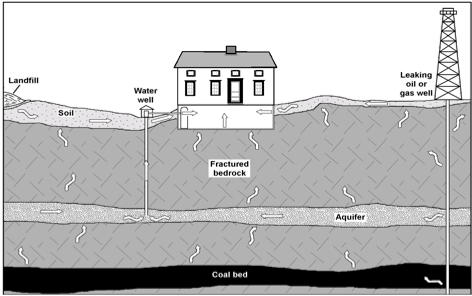Drilling and stray natural gas migration
From Wikimarcellus
| Revision as of 22:45, 7 November 2012 Tcopley (Talk | contribs) (movement of natural gas (mostly methane) through bedrock and soil) ← Previous diff |
Revision as of 00:27, 10 November 2012 Tcopley (Talk | contribs) (determined by its chemical signature) Next diff → |
||
| Line 1: | Line 1: | ||
| - | [[Image:Gas mig.png.scaled500.png|center|frame|<div align="center">'''Typical stray natural gas migration scenario'''<br>Source: ''The Pittsburgh Geological Society'', Natural Gas Migration Problems In Western Pennsylvania (Pamphlet).</div>]]] | + | [[Image:Gas mig.png.scaled500.png|center|frame|<div align="center">'''Typical stray natural gas migration scenarios'''<br>Source: ''The Pittsburgh Geological Society'', Natural Gas Migration Problems In Western Pennsylvania (Pamphlet).</div>]] |
| - | '''Stray natural gas migration''' refers to the movement of natural gas (mostly methane) through bedrock and soil. It can leak from a variety of sources, including reservoir rock, coal seams, landfill, or pipelines. It can also occur from drilling any well--gas, oil or water. Whenever the water table is penetrated by a well, methane gas may be given an escape route. It moves from areas of high pressure to low. | + | '''Stray natural gas migration''' refers to the movement of natural gas (mostly methane) through bedrock and soil. It can leak from a variety of sources, including reservoir rock, coal seams, landfill, or pipelines. It can also occur from drilling any well--gas, oil or water--as well as from abandoned wells. Whenever the water table is penetrated by drilling a well, methane gas may be given an escape route. It ends to move from areas of high pressure to low. |
| ===Identifying Stray Gas=== | ===Identifying Stray Gas=== | ||
| Stray gas is Quite common in regions of North America that are undergirded by hydrocarbon deposits, such as in southwestern and northeastern Pennsylvania. It can be found throughout the central and northern Appalachian Basin. When it occurs, it can be broken down into three main categories: | Stray gas is Quite common in regions of North America that are undergirded by hydrocarbon deposits, such as in southwestern and northeastern Pennsylvania. It can be found throughout the central and northern Appalachian Basin. When it occurs, it can be broken down into three main categories: | ||
| Line 7: | Line 7: | ||
| * Thermogenic gas consisting of natural gas or coal-bed gas. | * Thermogenic gas consisting of natural gas or coal-bed gas. | ||
| - | These gasses can blend together into a mixture of gases. | + | These gasses can blend together into a mixture of gases. The origin of stray natural gas may only reliably be determined by its chemical signature. |
Revision as of 00:27, 10 November 2012
Stray natural gas migration refers to the movement of natural gas (mostly methane) through bedrock and soil. It can leak from a variety of sources, including reservoir rock, coal seams, landfill, or pipelines. It can also occur from drilling any well--gas, oil or water--as well as from abandoned wells. Whenever the water table is penetrated by drilling a well, methane gas may be given an escape route. It ends to move from areas of high pressure to low.
Identifying Stray Gas
Stray gas is Quite common in regions of North America that are undergirded by hydrocarbon deposits, such as in southwestern and northeastern Pennsylvania. It can be found throughout the central and northern Appalachian Basin. When it occurs, it can be broken down into three main categories:
- Sub-surface microbial gas. These originate in deep sea sediments and may be identified as drift gas.
- Near-surface microbial gas often from landfills or naturally occurring marsh gas.
- Thermogenic gas consisting of natural gas or coal-bed gas.
These gasses can blend together into a mixture of gases. The origin of stray natural gas may only reliably be determined by its chemical signature.


